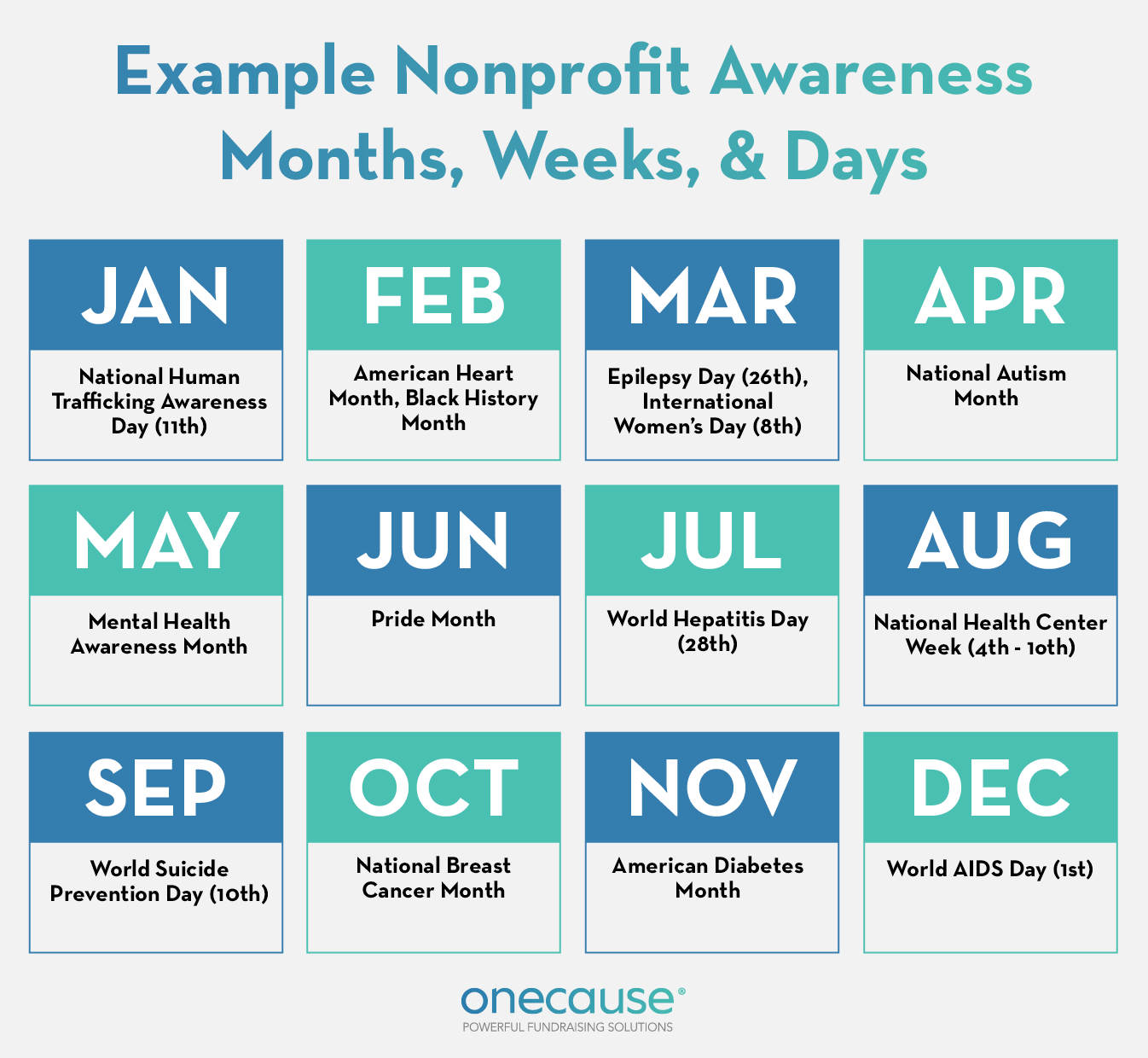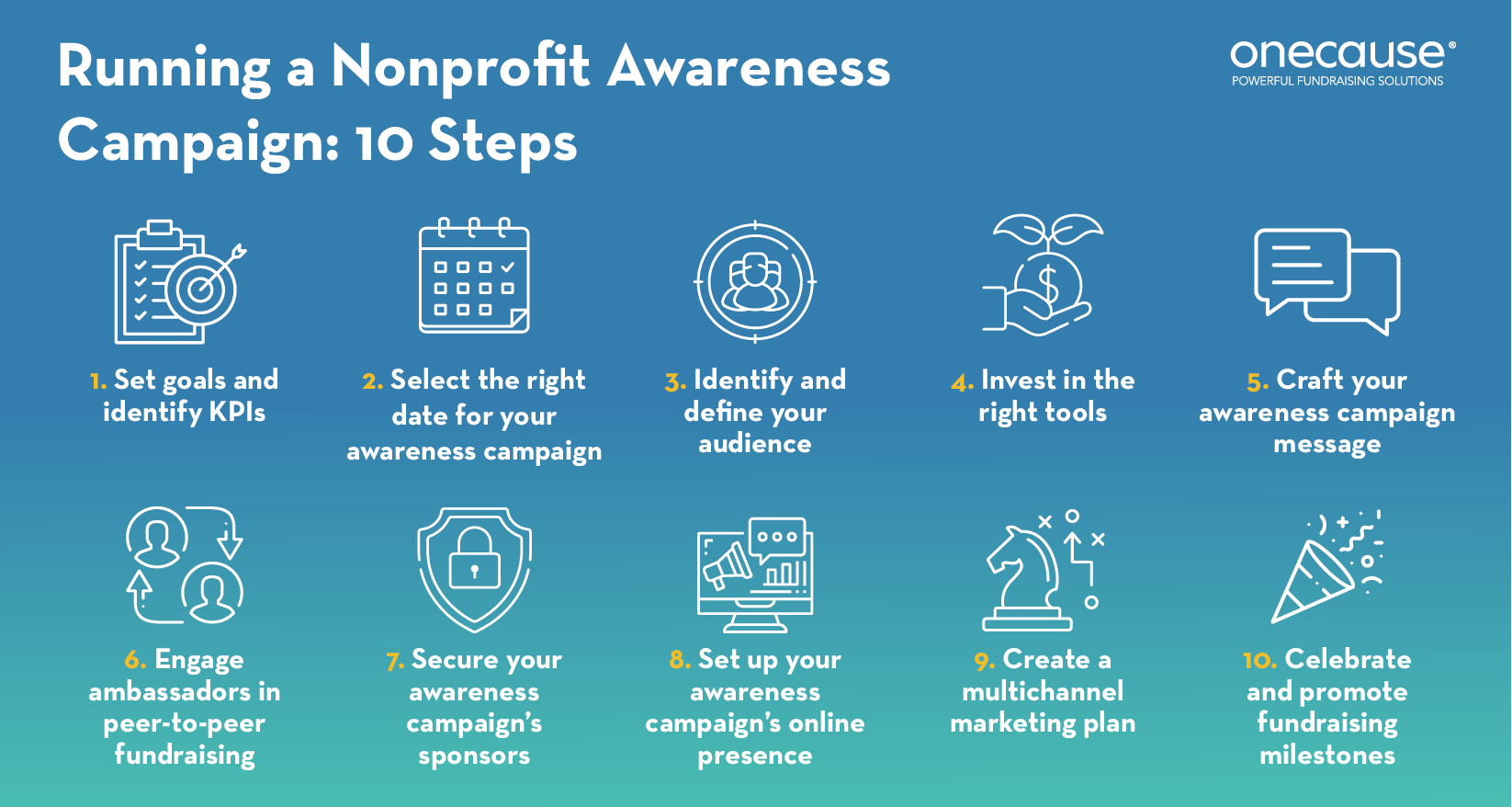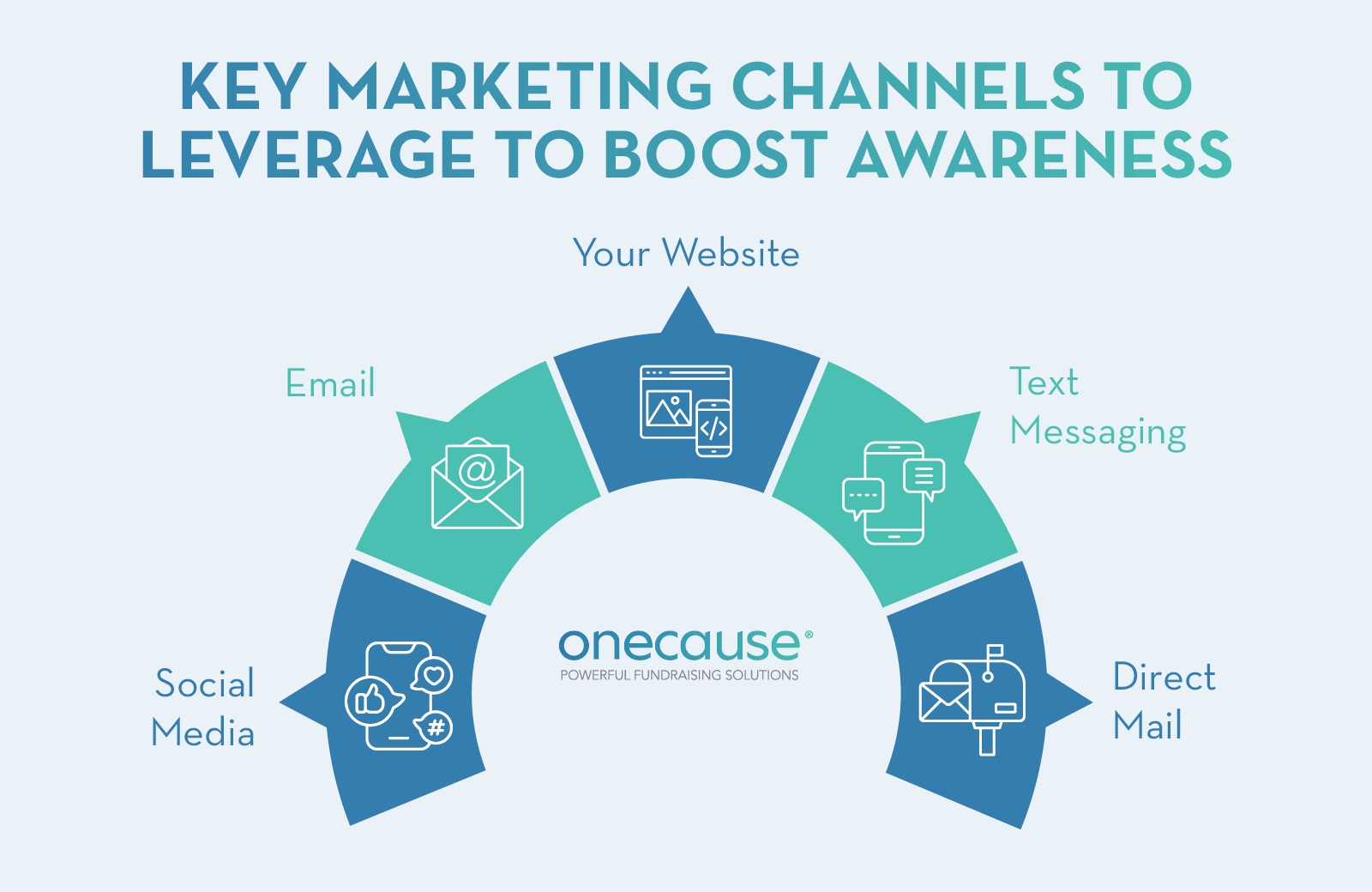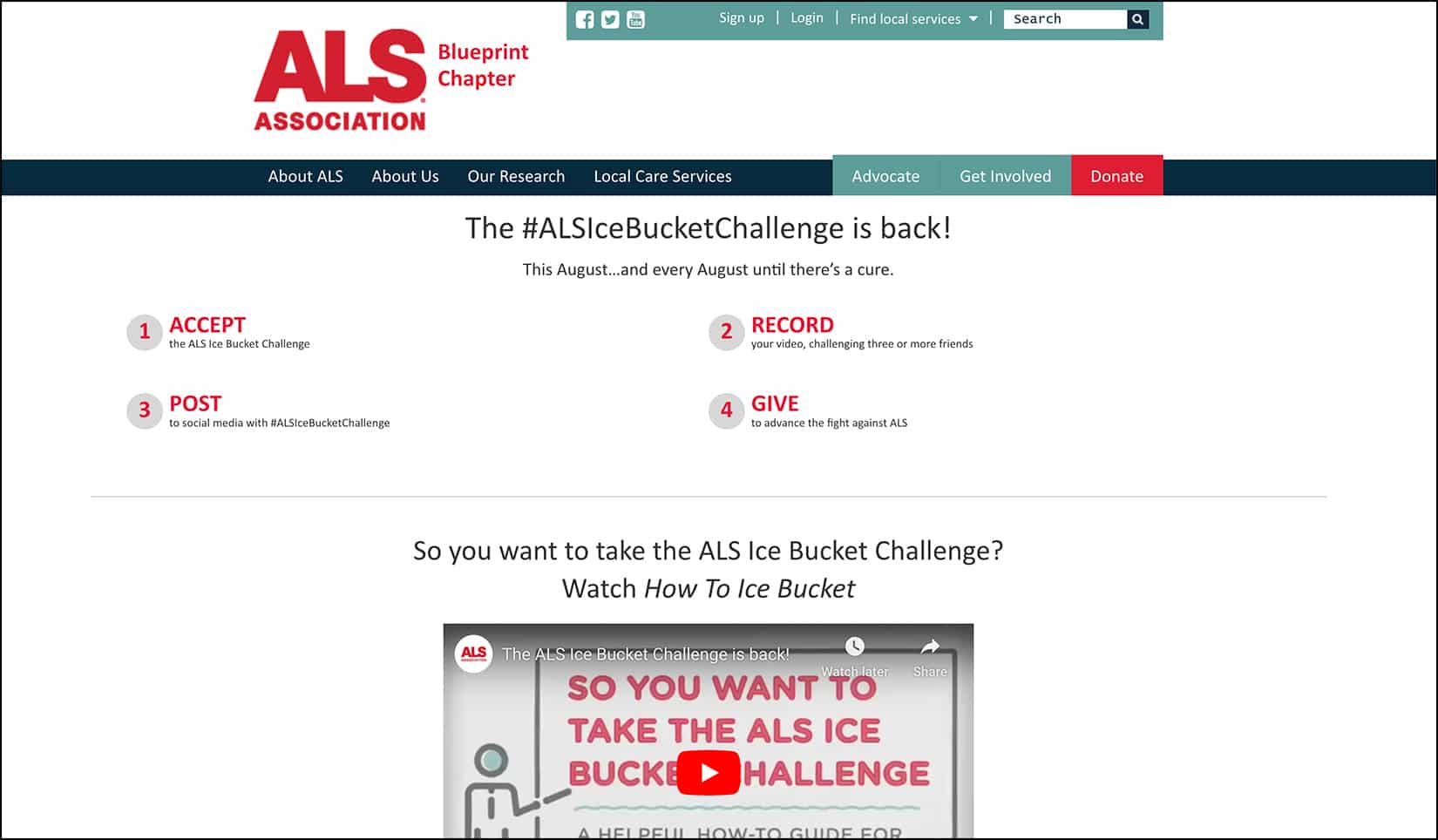How to Create a Standout Nonprofit Awareness Campaign
Awareness campaigns are one of the most popular, effective, and flexible ways to raise public interest and educate your community about your nonprofit’s mission. Plus, they generate long-term fundraising potential – on average, 40% of giving and awareness day participants are new donors.
This makes awareness campaigns an exciting opportunity to broaden your donor base and drive support for your mission. To help you host an impactful awareness campaign, we’ll cover everything you need to know:
- Awareness Campaign FAQs
- 10 Steps to Starting an Awareness Campaign
- Sample Awareness Campaign Timeline
- Tips for Running a Successful Public Awareness Campaign
- 5 Top Awareness Campaign Examples
You don’t need to be a multi-million-dollar organization to get the word out about your cause. All you need are the right strategies and tools to put your organization on the map. Let’s dive in!
Awareness Campaign FAQs
What are awareness campaigns?
An awareness campaign is a time-bound, strategic campaign primarily intended to increase public visibility for your cause. For nonprofits, that means spreading the word about your mission, explaining why it matters, and showing how people can make a difference through your work.
When done right, awareness campaigns help you educate new audiences, build credibility, and inspire meaningful action that fuels your mission long after the campaign ends.
What are the benefits of leading a nonprofit awareness campaign?
Nonprofit awareness campaigns provide three main benefits:

- Boost your organization’s brand visibility: Reach a wider audience and enhance your organization’s brand recognition.
- Educate the public about an important issue: Share your mission and how you support a specific cause to inspire engagement.
- Encourage supporters to deepen involvement: Capture the audience’s attention to establish a connection with your organization and inspire action.
In addition to these benefits, awareness campaigns have the power to skyrocket your nonprofit’s cause to viral success. You’ve most likely heard of one of the biggest awareness campaign success stories in history, the ALS Ice Bucket Challenge. This well-executed challenge raised more than $115 million for ALS research since it began in 2024, proving how an awareness campaign can give you more reach than ever before.
What are the main goals of a public awareness campaign?
The main goal of an awareness campaign is to increase visibility for your organization. By spreading awareness of your nonprofit’s cause, you’ll grow your audience and build a stronger support base to drive your mission forward long-term.
But because awareness itself can be hard to quantify, it’s helpful to track a few key performance indicators (KPIs):
- Audience growth metrics: the number of new social media followers, email subscribers, volunteers, event guests, etc.
- Digital engagement metrics: click-through rates (CTR), new site visits, organic traffic, and the number of likes and shares on social media posts.
Remember, raising money isn’t the primary goal of these campaigns. While your efforts will likely result in increased donations, your focus should be on spreading the word and showing a wider audience why your work matters. Donations will follow!
When should a nonprofit launch an awareness campaign?
You can launch an awareness campaign any time, but many nonprofits choose to align theirs with a national awareness day, week, or month to capitalize on existing public attention. For instance, a nonprofit that provides maternal health resources for Black women might host its campaign during Black History Month in February.
There are hundreds of national awareness months and days, so do your research to identify one that aligns best with your specific cause. Here are a few popular ones to start with:
- January 11: National Human Trafficking Awareness Day
- February: American Heart Month and Black History Month
- March 8: International Women’s Day
- March 26: Epilepsy Day
- April: National Autism Month
- May: Mental Health Awareness Month
- June: Pride Month
- July 28: World Hepatitis Day
- August 4-10: National Health Center Week
- September 10: World Suicide Prevention Day
- October: National Breast Cancer Month
- November: American Diabetes Month
- December 1: World AIDS Day
These ‘unofficial holidays’ are typically designated by the government, nonprofits, or private organizations to raise awareness about a specific issue. They often focus on educating the public about a cause and what they can do to help, making them the perfect time to host your own awareness campaign.
What fundraising tools do I need to host an awareness campaign?
To host a successful awareness campaign, you’ll need tools to amplify your message, engage supporters, and track impact. Look for a branded online giving page, flexible donation options, real-time progress tracking, and integrated donor data to keep everything running smoothly. An all-in-one solution like OneCause brings these tools together, helping you streamline fundraising and maximize your campaign’s reach.
How do you measure the ROI of a nonprofit awareness campaign?
OneCause measures ROI using built-in, configurable reporting and real-time analytics that track donor behavior, campaign engagement, and fundraising performance. Nonprofits can view dashboards showing participation and donation trends, connecting awareness efforts directly to fundraising outcomes and sponsor value.
10 Steps to Starting an Awareness Campaign
Follow these tried-and-true steps to craft the perfect awareness campaign for your organization.
1. Set goals and identify KPIs for your campaign.
Start planning your awareness campaign by determining its purpose. Decide on what you’re trying to accomplish by asking yourself the following questions:
- What’s the current public perception of our cause?
- What part of our cause needs visibility now?
- What aspects of our mission do we want to draw the most attention to?
- Will we target mainly existing donors or aim to grow our audience with new supporters?
The answers to these questions will shape the specific strategies and goals that you lay out for your awareness campaign.
On top of establishing your goal, decide how you’ll quantify that growth and visibility by determining your key performance indicators (KPIs). You might track metrics such as:
- Number of clicks, shares, or likes on shared content
- Event attendance or tickets purchased
- Subscribers or followers gained throughout the campaign
- Traffic on your awareness campaign’s landing page
It’s important to set your goals early in the planning process, along with the specific KPIs you’ll use to measure them. Once you’ve determined what you’re aiming for, it’s much easier to craft a strategy to get you there.
2. Select the right date for your awareness campaign.
As with any campaign, you need to allow enough time for your team to plan your awareness strategies and for your audience to thoroughly engage with it. This helps your cause to maintain momentum throughout the campaign.
If your campaign coincides with an existing national awareness month, week, or day, build your timeframe around it. For a standalone campaign, consider your audience and the scale of your goals when choosing a timeframe. Will a single day of awareness activities be enough to help you reach supporters, or will a week or month be better suited for your goals?
Regardless of the exact focus of your campaign, we recommend either kicking off or concluding it with a main event (either in-person, virtual, or hybrid). An event will help you capitalize on your audience’s energy to keep them engaged beyond your campaign. Remember to give yourself enough time to plan and promote the main event to supporters.
3. Identify and define your campaign’s audience.
While awareness campaigns might target a nonprofit’s entire supporter base, this isn’t always the case. You’ll need to consider who you’re hoping to engage so you can develop the most effective marketing plan and outreach strategies. Narrowing down your audience can help your team better target the message, voice, and specific communication channels of your campaign.
Explore your CRM to learn more about audience demographics and answer questions like:
- Who has participated in past awareness campaigns?
- Who are our most loyal supporters in terms of long-term engagement, donations, and event attendance?
- Where are most of our supporters located?
- How old are our target supporters?
- What types of campaigns or messages have been most effective at engaging them?
As you answer these questions, think about where these donor segments overlap. Those intersections will be ideal places to focus your efforts. For instance, supporters who’ve given to your organization before, are in your city or region, and engaged with you through an online channel might be the perfect segment to re-engage through an awareness campaign.
As your campaign strategies develop, continue fine-tuning your outreach using audience segments and past data on marketing campaign performance.
4. Invest in the right tools for your awareness campaign.
Running an awareness campaign involves many moving parts, from developing your communications strategy to setting up an online fundraising page where inspired supporters can give. Rather than overwhelming your nonprofit’s team with time-consuming tasks, leverage an all-in-one solution like OneCause that has everything you need to run an impactful awareness campaign, including:

Online Fundraising
Online fundraising brings people together in a social, accessible, and fun way that creates lasting bonds with your organization. Unlock your fundraising potential with OneCause features designed to help you connect with today’s donors and make giving easier than ever, like:
- Online Giving Sites: Quickly build branded giving sites to share your nonprofit’s mission and drive awareness.
- Donation Forms: Take the friction out of your forms and make it easy for supporters to give.
- Personal Fundraising Pages: Empower your cause champions to fundraise on your behalf with easy-to-use fundraising tools.
With these tools in place, you’ll empower your supporters to give seamlessly, helping you spread awareness and drive donations faster.
Peer-to-Peer Fundraising
Peer-to-peer software helps you harness the power of your donors’ social networks to drive donations, making them an invaluable recruiting tool for your awareness campaign. OneCause provides you with interactive tools to share compelling stories, impact metrics, and resources to maximize your campaign’s potential.
With our fundraising solution, your supporters can effortlessly create personalized fundraising pages to share with their network, making it easy for them to help raise visibility and funds on behalf of your organization. Its features include:
- Team and individual fundraising pages that participants can personalize to raise more funds for your campaign.
- Leaderboards that highlight top donors and supporters front and center on your website and are updated in real-time.
- Milestones, badges, and awards to gamify giving and encourage friendly competition.
- Matching gift functionality to deepen partnership relationships and increase donors’ impact.
- Built-in messaging to thank donors, recognize achievement, and sustain giving momentum.
- Social sharing links that make it easy for supporters to quickly share campaign details with their followers.
Give your supporters the tools and technology they need and watch your peer-to-peer participants soar to new heights.
Text2Give®
Every second counts during fast-paced awareness campaigns, and when donors are inspired to give, Text2Give® makes it quick and effortless. Supporters can donate in seconds by texting a keyword to a designated number. With an instant link to a mobile-friendly donation page, contributing to your cause has never been easier.
Whether you want to spread the word about your mission or solicit donations, Text2Give® is the perfect solution. Empower spontaneous generosity and unlock a world of new donor engagement with a seamless donation experience.
Social Media Integration
With social media integration, OneCause makes marketing your campaign a breeze. This cost-effective feature helps supporters share their fundraising pages and tap into a wider audience to attract more attention. By seamlessly connecting your campaign to social media platforms, you’ll boost visibility, drive and maintain engagement, and help spread your message with minimal effort.
Real-Time Analytics
Grow support for your awareness campaign by using analytics to identify high-performing strategies and opportunities to engage brand-new supporters. Your fundraising solution should empower you to effectively track and analyze your campaign’s success.
From measuring your levels of supporter engagement to giving results in real-time, these insights allow for quick adjustments to your strategy so that you can stay on track toward your fundraising and awareness goals.
5. Craft your awareness campaign message.
To create the most effective messages, focus on a particular aspect of your mission that resonates deeply with your audience. Narrowing your focus adds clarity and creates an emotional connection, making it easier for supporters to understand the impact of their contributions.
For example, if your nonprofit’s mission revolves around education and children’s welfare, your awareness campaign might focus on literacy issues among your community’s youth.
A well-crafted awareness campaign message provides your audience of new supporters with a specific issue to rally behind. By addressing a specific challenge, you can effectively introduce them to your broader mission, inspiring them to take action and build a deeper connection with your cause.
6. Engage ambassadors in peer-to-peer fundraising.
Involving your board, volunteers, supporters with large social media followings, and business connections can help to significantly expand your campaign’s visibility.
We recommend enlisting your most ardent supporters as “ambassadors.” Ambassador fundraising offers a way to turn these loyal supporters and donors into active advocates and fundraisers for your awareness campaign.
Here are ways these supporters can help:
- Recruit new peer-to-peer fundraising participants
- Spread the word about your mission online
- Promote your virtual awareness events and secure registrations
To set expectations early, let your ambassadors know your goals and the timeline for your campaign to maximize your organization’s exposure.
7. Secure your awareness campaign’s sponsors.
Leverage your organization’s community and network to heighten your campaign’s visibility. Consider securing a corporate sponsor to support your awareness campaign efforts.
For example, a well-known organization, the Susan G. Komen Foundation, has a long-time partnership with Bank of America, allowing them to work with other major corporations and expand their exposure with the infamous pink ribbons.
With this heightened visibility, you can get your awareness campaign in front of thousands of people and tap brand-new audiences to get involved in your mission. If you’re planning an event to launch or conclude your campaign, that’s also the perfect time to ask a sponsor to help bring it to life by sending a sponsorship package. A sponsor can offer financial support and access to a greater network and extensive resources.
8. Set up your awareness campaign’s online presence.
Once you’ve established your campaign’s core guidelines and strategies, the next step is to inspire your supporters to take action. To simplify this process, invest in an online fundraising platform that makes it easy for supporters to engage, support, and donate to your nonprofit with a dedicated microsite.
A centralized campaign page is key to your awareness campaign’s success and should include donation tools and plenty of information about your mission and impact. Specifically, make sure your site has the following:
- Your nonprofit’s visual and verbal branding.
- Impact statements that explain the intention behind your awareness campaign.
- High-quality photos and videos that engage the audience and motivate them to get involved.
- Embedded registration if your campaign concludes with an event.
- Link to donation page with recurring options to raise more.
For more complex awareness campaigns that include ambassador fundraising and virtual awareness events, an all-in-one fundraising platform will also help maximize engagement and provide the best possible experience to new supporters.
9. Create a multichannel marketing plan.
Marketing an awareness campaign is all about maximizing multichannel reach. To connect with your audience effectively, ensure your campaign spans multiple channels, allowing you to engage supporters wherever they are. This strategy not only broadens your impact but also drives more traffic back to your core campaign web page. Popular marketing channels to consider include:
- Social media posts: Create a comprehensive content calendar to track what and when you’ll post about your awareness campaign.
- Emails: Highlight your awareness campaign in your email newsletter and explain ways to get involved.
- Your website: Create a strong landing page that explains the purpose behind your campaign and directs users to your microsite with clear CTAs.
- Text messaging: Text your supporters with awareness campaign updates to keep them in the loop and invested in your mission.
- Direct mail: Send personalized invitations to VIP supporters to lead a peer-to-peer fundraiser or get involved in other impactful ways.
A key best practice is to identify where and how your supporters prefer to learn about your mission before launching your campaign. If most of your donors prefer to receive phone calls, it might be a good idea to strengthen your outbound call team. Or, if social media seems to draw the most donations, step up your content schedule to post multiple times per day.
Be sure to actively direct your audience back to a central location (your campaign microsite) where they can take the next steps like signing up for an event or donating.
10. Celebrate and promote awareness milestones.
Throughout your awareness campaign, every win deserves a moment in the spotlight. Share key milestones to keep your supporters in the loop! Milestones to celebrate include:
- Gaining 1,000 new followers across social media
- Acquiring 100+ new donors
- Raising $1,000 toward your fundraising goal
- Reaching over 100 donations
There are countless ways to acknowledge these achievements and show appreciation for your supporters. Share a video on social media highlighting key milestones or give personalized shoutouts to your top donors. Engaging with your supporters in meaningful ways helps them feel like an integral part of your success story.
Remember, awareness campaigns are all about building long-term relationships with existing donors and attracting new supporters who can help drive your mission forward over time. With these ten steps, your team can get your next awareness campaign up and running in no time.
Sample Awareness Campaign Timeline
When it comes to nonprofit awareness campaigns, timelines are key. To succeed, you need to send out the right messaging to the right people at the right time. And to stand out from the competition, your supporters need to know as soon as possible when the campaign will be so they can prepare.
Use this sample timeline to structure your upcoming campaign:
3-6 Months Out
- Set goals and KPIs. Make sure your team is on the same page about what you want to accomplish with this campaign and how you’ll measure success.
- Lock in your fundraising tech stack. Set up your fundraising platform, donation forms, mobile giving tools, and peer-to-peer capabilities. Map out exactly how each will support your campaign strategy.
- Plan your PR and marketing strategy. Craft campaign messaging, design visual assets, and create a compelling tagline. Outline your multichannel promotional strategy (email, social, SMS, web, PR, etc.).
- Approach potential sponsors and VIP donors. Are there any local businesses or other nonprofits in the area you might partner with to increase awareness? Contact these potential partners and any VIP donors to ask and thank them for their support.
1-2 Months Out
- Determine your day, week, and month-of execution plan. Assign staff responsibilities, confirm vendors, and nail down timelines for creative, promotions, landing pages, and event logistics (if applicable).
- Begin promoting your campaign. Send out save-the-date emails and postcards and launch your social media campaign. Include mission-focused messaging in all communications, and ramp up your efforts the closer you get to the awareness day or month.
- Highlight stories and impact statements. Share beneficiary stories and be sure to include impact statements in all outreach and on giving pages.
1 Week Out
- Review your messaging and calls to action. Ensure all CTAs are clear and appropriately linked. Additionally, test your donation forms and procedures in case supporters are inspired to donate.
- Ramp up campaign promotion. Increase posting frequency, spotlight campaign champions and supporters, and leverage short-form social video or live content. Include the details about your mission in every post, message, and piece of content.
- Create follow-up and donor stewardship plans. Begin drafting thank-you messaging for supporters, donors, sponsors, and partners. How will you keep new supporters engaged in your mission once the campaign ends?
During Your Awareness Day, Week, or Month
- Make participating easy with clear CTAs. Help supporters get to know your organization with direct links and easy actions to take. Include CTAs in every email, social post, and traditional marketing promotion.
- Maintain a strong social media and online presence. Rely heavily on social media and use clever hashtags to encourage engagement and social sharing as the campaign goes on.
- Thank your donors and volunteers throughout the campaign. Don’t wait until the end to say thank you! Be consistent with your appreciation and recognition throughout your entire campaign timeframe.
Tips for Running a Successful Public Awareness Campaign
While there will always be competing awareness campaigns, it’s possible to break through the noise with a stellar awareness strategy. Use these tips to help your organization stand out.
Make the Most of Social Media
The best part of any awareness month is all of the social media coverage, so be prepared to take full advantage of the “free” publicity. With the right social media strategy in place, your campaign can transcend a mere month or day to create a lasting impression.
Here are some awareness month social media best practices to keep in mind:
- Include attention-grabbing imagery on all your posts. Engaging photos drive action. Research shows that social media posts with images receive 150% more engagement than text-only posts.
- Involve your sponsors. Tag other organizations, partners, sponsors, and even media outlets in your posts for maximum exposure.
- Check your nonprofit’s hashtag. Keep tabs on any mentions of your nonprofit and uses of your campaign hashtag. Like, repost, or share when supporters share your campaign details.
- Integrate social posts with your website. Create a running ‘social feed’ so visitors can see what supporters are saying about your campaign.
- Encourage sharing. Ask donors and supporters to share any social posts with their networks for even more visibility.
During an awareness day or month, all nonprofits focusing on that specific cause area will likely post to promote their campaigns. Leveraging social media is a great way to take advantage of these other organizations’ promotional efforts while increasing visibility for your cause as a whole.
Align Major Fundraising Events with Your Awareness Month
Consider scheduling your nonprofit’s main fundraising event during the awareness month (or week) that’s most closely associated with your cause to maximize exposure and increase reach without having to do all of the heavy lifting yourself. You can easily build on the momentum of the awareness month and motivate supporters around a tangible fundraising event.
When scheduling events in conjunction with awareness campaigns, ask yourself:
- Are there any dates within the month with additional significance, such as a founding milestone?
- Will our donors recognize the importance of this date?
- Can the majority of key stakeholders, including board members, make this date and time work?
- Are any other organizations hosting an event at this same time? Should we try to partner up?
Hosting a major event during your awareness campaign does add extra work to your team’s plate, so be sure to create detailed plans and calendars if you go this route. Determine a promotion strategy well ahead of time and integrate it naturally with your awareness campaign.
Find a Unique Angle to Stand Out from the Crowd
With so much competition, nonprofits can often get lost in the crowd. A lack of bandwidth throughout most of the year makes it hard to stand out among larger organizations, but awareness days or months can shine new light on your nonprofit.
To highlight your organization, find a creative angle for your awareness campaign. What makes your organization unique? Why is your nonprofit the one to support during this awareness month? Identify this authenticity and highlight it throughout your marketing efforts.
Take Advantage of Increased Media Attention
Awareness days and months give associated nonprofits the potential to increase their influence, which can put your cause at the top of supporters’ minds.
Tap into this attention during your awareness campaign by:
- Partnering with like-minded local organizations that can spread your message to the local community.
- Sharing relevant news articles, blog posts, and press releases as part of your campaign communications.
- Contacting local businesses or corporations with shared values to ask about potential sponsorship opportunities.
It’s easy to leverage this attention to drive donations to your cause with the right fundraising platform in place.
5 Inspiring Awareness Campaign Examples
1. ALS Ice Bucket Challenge
You’re more than likely familiar with the famous ALS Ice Bucket Challenge, an awareness campaign hosted by the ALS Association, which challenged people all over the world to pour a bucket of ice over their heads. This viral success story resulted in over $115 million for ALS research and jumpstarted global discussions around ALS for the very first time.
Why did the ALS Ice Bucket Challenge make such a significant impact? Because it leveraged the power of social media and used a unique challenge that was perfect for summertime! The shareability of the campaign was baked into the challenge itself, where participants had to tag their friends to join in and donate to the ALS foundation.
Viral challenges and impactful messaging can help to start critical conversations and drive engagement by creating a knowledge gap. Your awareness campaign should introduce new supporters and readers to your mission in a way that gets them curious to learn more.
2. Lee Health: Pedal for a Purpose
The Lee Healthy Life Center provides a variety of services and education to support healthy lifestyles, early detection of disease, and chronic disease management. To help people learn more about cancer care, they planned an event that shared the message of prevention and awareness while bringing the community together.
Lee Health decided to cycle toward a healthier future for all by hosting Pedal for a Purpose. Participants pedaled in an exciting 4-hour pedal-a-thon to raise critical funds for the Lee Health Cancer Institution, and with an ambitious goal of $50,000, Lee Health trusted OneCause to help reach their goal.
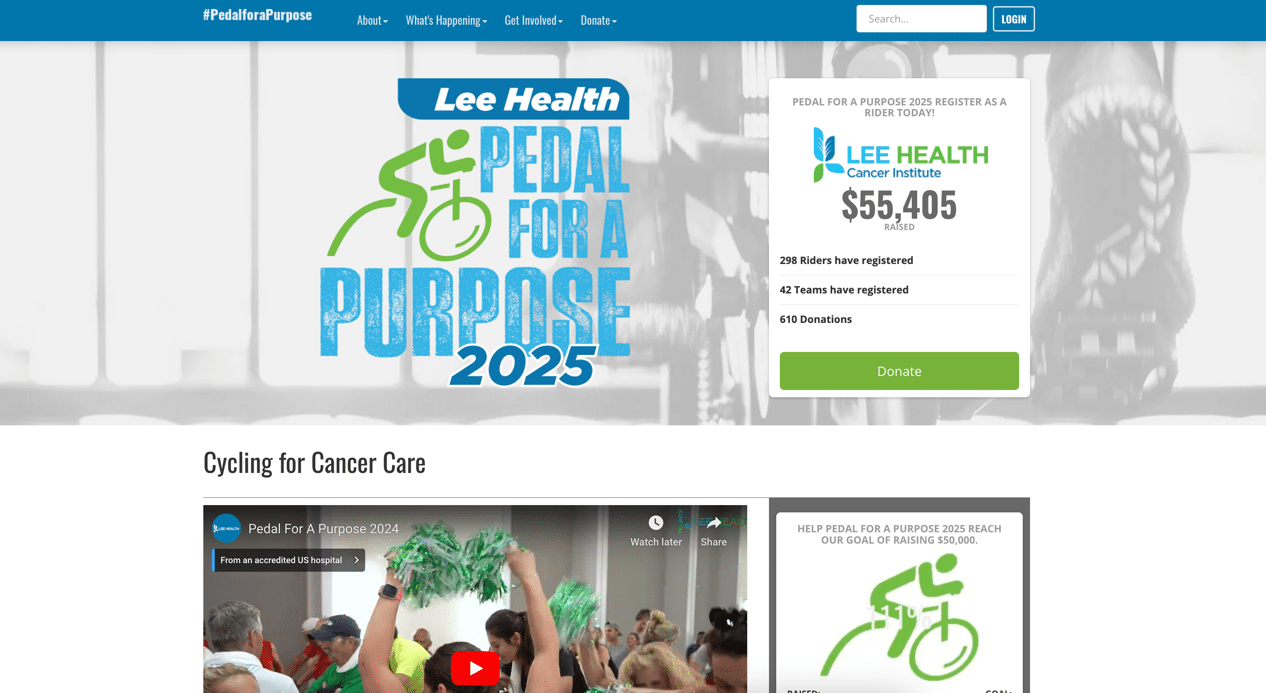
Throughout their campaign, Lee Health:
- Raised 111% of their fundraising goal
- Rallied 298 bike riders
- Secured 610 donations
By creating a Peer-to-Peer fundraising page, powered by OneCause, Lee Health was able to leverage impact levels to share how certain gift amounts would strengthen its mission and leaderboards to keep the cycling momentum going.
3. Canadian Pulmonary Fibrosis Foundation: Community Walks
Each year, Canadian Pulmonary Fibrosis Foundation (CPFF) supporters gather to raise awareness, hope, and funds for those battling pulmonary fibrosis. To shine a light on the cause, CPFF gathered supporters from across the nation to join for in-person and virtual walks throughout August and September.

By partnering with OneCause, CPFF was able to raise 163% of its original goal! To encourage participation, their organization took advantage of the following Peer-to-Peer solution features:
- Leaderboards: Top fundraisers and teams were highlighted to recognize and celebrate their achievements.
- Donor wall: Supporters who signed up were showcased along with their personal fundraising pages.
- Activity feed: Real-time updates were shared to highlight progress, celebrate impact, and inspire action.
CPFF had the opportunity to keep participants motivated, engaged, and active throughout their awareness campaign and build meaningful, lasting relationships.
4. Trustbridge Hospice Foundation: Uptown 5K on the Runway
Serving patients and families in the Palm Beach area, Trustbridge Hospice Foundation offers programs and services to assist those in their time of need. In partnership with the Fort Lauderdale Executive Airport (FXE), Trustbridge aimed to raise awareness to provide extraordinary care for everyone in their community, including those without insurance coverage or the ability to pay.
Through their partnership, Trustbridge hosted a unique run/walk 5K on the FXE runway, inviting community members of all ages.
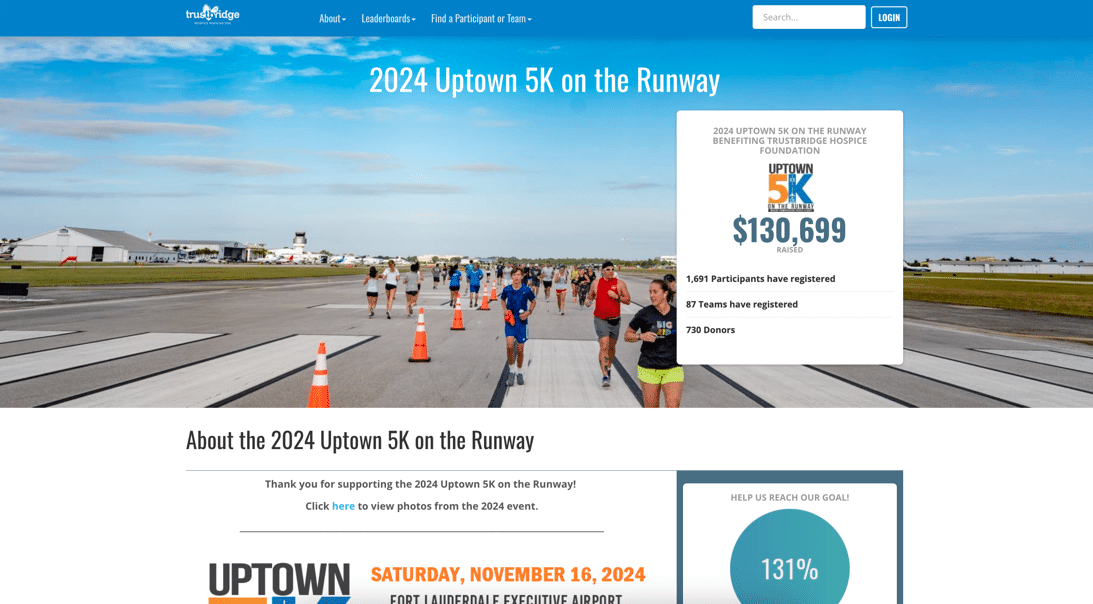
Because their 5K was free to register, Trustbridge leaned on Peer-to-Peer fundraising by OneCause to empower supporters to create teams and develop personal fundraising pages with easy-to-use tools.
Here are a few of the outcomes of this awareness campaign:
- Raised $130,699, 131% of their fundraising goal.
- Fostered a sense of community with 87 registered teams.
- Leveraged the power of social media with hashtags like #5KRunway.
This success story reflects the value of utilizing social media hashtags, creative challenges, and peer-to-peer fundraising tools to elevate important conversations and grow your donor base.
5. National Ovarian Cancer Coalition: Together in TEAL
The National Ovarian Cancer Coalition works to prevent and cure ovarian cancer while improving the quality of life for survivors and their caregivers. To elevate their efforts, they hosted an awareness campaign, Together in TEAL, during National Ovarian Cancer Month.
By linking their campaign to an awareness month, this organization was able to tap into the heightened public attention, increase visibility, and rally support from a wider audience.
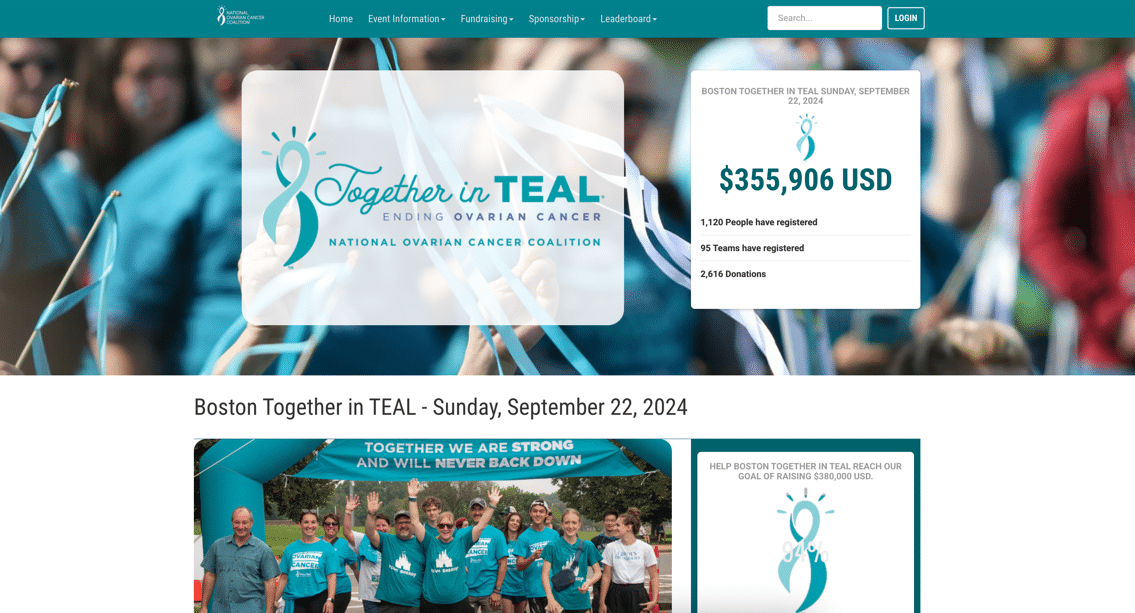
Here are key strategies that helped Together in TEAL maximize its potential:
- Leverage compelling multimedia stories to show the tangible impact of their donors’ contributions.
- Feature authentic testimonials that emphasize the value and significance of their community’s support.
- Recruited via social channels to drive awareness and engagement to their campaign page.
The OneCause Peer-to-Peer fundraising solution made it easy for the National Ovarian Cancer Coalition to combine authentic storytelling and social media outreach to boost awareness and raise $355,906 in support of cancer prevention and care.
Getting Started with Your Awareness Campaign
With the strategies outlined in this guide, your team can reach broader audiences and drive visibility for your mission. After all, awareness campaigns have the power to engage supporters in quicker, more casual, and more impactful ways than formal fundraising campaigns. And OneCause is here to help! Contact our team to learn how our modern, flexible, and seamless fundraising platform can help you drive deeper engagement.
Want more resources first? Keep exploring with these additional guides and pages:
- The Ultimate Guide to Giving & Awareness Days. Planning your awareness campaign around a single day? Download our free eBook to learn how to maximize its potential.
- Unlocking the Secret to Peer-to-Peer Fundraising Success. Leverage the power of social proof during your awareness campaign with peer-to-peer and ambassador fundraising.
- OneCause Giving Days & Awareness Campaigns. Discover how the OneCause Fundraising Platform can help you drive donations during your upcoming campaign.

